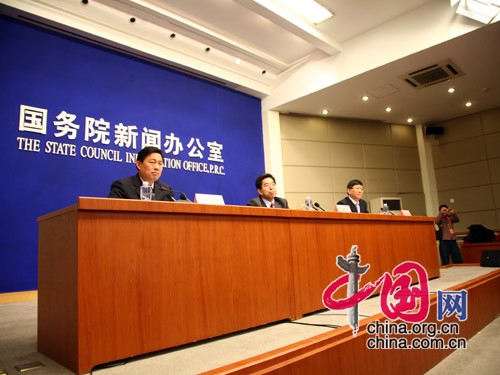|

|
|
Ma Jiantang (middle), director of the National Bureau of Statistics (NBS), releases key economic data for the year 2008 at a news conference held in Beijing on January 22, 2009. [china.org.cn] |
China's economy cooled to its slowest pace in seven years in 2008, expanding 9 percent year-on-year as the widening global financial crisis continued to affect the world's fastest-growing economy, official data showed Thursday.
Gross domestic product (GDP) reached 30.067 trillion yuan (US$4.4216 trillion) in 2008, Ma Jiantang, director of the National Bureau of Statistics (NBS), told a press conference.
The 9-percent rate was the lowest since 2001, when an annual rate of 8.3 percent was recorded, and it was the first time China's GDP growth fell into the single-digit range since 2003.
The year-on-year growth rate for the fourth quarter slid to 6.8 percent from 9 percent in the third quarter and 9.9 percent for the first three quarters, according to Ma.
Economic growth showed "an obvious correction" last year, but the full-year performance was still better than other countries affected by the global financial crisis, said Zhang Liqun, a researcher with the Development Research Center of the State Council, or cabinet.
He attributed the fourth-quarter weakness to reduced industrial output as inventories piled up amid sharply lower foreign demand.
Exports, which accounted for about one-third of GDP, fell 2.8 percent year-on-year to US$111.16 billion in December. Exports declined 2.2 percent in November from a year earlier.
Industrial output rose 12.9 percent year-on-year in 2008, down 5.6 percentage points from the previous year, said Ma.
Economist Wang Xiaoguang said the 6.8-percent growth rate in the fourth quarter was not a sign of a "hard landing," just a necessary "adjustment" from previous rapid expansion.
"This round of downward adjustment won't bottom out in just a year or several quarters but might last two or three years, which is a normal situation," he said.
A report Thursday from London-based Standard Chartered Bank called the 6.8-percent growth in the fourth quarter "respectable" but said the data overall presented "a batch of mixed signals."
It said: "We probably saw zero real growth in the fourth quarter compared with the third quarter, and it could have been marginally negative."
However, officials and analysts said some positive signs surfaced in December, which they said indicated China could recover before other countries.
December figures on money supply, consumption, and industrial output showed some "positive changes" but whether they represented a trend was unclear, said Ma.
Outstanding local currency loans for December expanded by 771.8 billion yuan, up 723.3 billion from a year earlier, according to official data.
Real retail sales growth in December accelerated 0.8 percentage points from November to 17.4 percent. Industrial output also accelerated in December, up 0.3 percentage points from the annual rate of November.
Wang Qing, Morgan Stanley Asia chief economist for China, said GDP growth would hit a trough in the first or second quarter. China will perform better than most economies affected by the global crisis and gradually improve this year, he said.
Zhang also predicted the economy will touch bottom and start to recover later this year, depending on the performance in January and February.
Zhang forecast GDP growth of more than 8 percent for 2009, based on the assumption that domestic demand and accelerating urbanization would help cushion China from world economic conditions.
Wang Tongsan, an economist with the Chinese Academy of Social Sciences, said whether GDP growth exceeds 8 percent this year depends on how the world economy performs and how well the government stimulus policies are implemented.
Ma characterized the "difficulties" China experienced in the fourth quarter as temporary, saying: "We should have the confidence to be the first country out of the crisis."
Overall, the economy maintained good momentum with fast growth, stable prices, optimized structures and improved living standards, said Ma.
China's performance was better than the average growth of 3.7 percent for the world economy last year, 1.4 percent for developed countries and 6.6 percent for developing and emerging economies, he said, citing estimates of the International Monetary Fund.
"With a 9-percent rate, China actually contributed more than 20 percent of global economic growth in 2008," said Ma.
He said the industrial structure became "more balanced" last year, with faster growth of investment and industrial output in the less-developed central and western regions than in the eastern areas.
(Xinhua News Agency January 22, 2009)